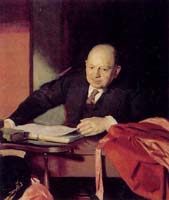The first Conflic ts Restatement (1934) and its drafter, Professor Joseph Beale, have been the favorite punching bags of every conflicts teacher, well before the Restatement was toppled by the conflicts revolution of the 1960s. Because history is often written by the victors, it is worth asking whether Beale and his Restatement were as bad as their reputation.
ts Restatement (1934) and its drafter, Professor Joseph Beale, have been the favorite punching bags of every conflicts teacher, well before the Restatement was toppled by the conflicts revolution of the 1960s. Because history is often written by the victors, it is worth asking whether Beale and his Restatement were as bad as their reputation.
This Article is not an attempt to rehabilitate them. Rather it is a necessary historical journey undertaken with all the trepidation of a traveler who expects the worst but hopes for at least some small pleasant surprises. It revisits Beale and the Restatement in the context of their own time–the 1920s–and examines Beale's life and work, the state of American conflicts law before him, the criticisms of his contemporaries, and the imperfect process that produced the Restatement. For the impatient reader, the short answer to the above question is that, generally, the bad reputation is deserved. However, the journey is rewarding for what one discovers along the way.
Without Beale, there would not have been a Conflicts Restatement and, primarily because of Beale, the Restatement could not have been any better than it was. Even so, it is not clear that American conflicts law would have been better of without a Restatement at all. The prevailing view that the Restatement impeded the development of American conflicts is partly offset by some byproducts of the Restatement process. The Restatement is the beginning of modern American conflicts law. Although it is better to start on the right foot, sometimes starting on the wrong foot is better than not starting at all. The Restatement unified and systematized the previously scattered and neglected conflicts law, brought it to the attention of bar and bench, earned for it a place in the curriculum of all law schools, and galvanized the opposition among the legal realists and other academics. In turn, this led to the production of outstanding scholarship that brought the renaissance of American conflicts law during the next generation and eventually the conflicts revolution. Understanding the Restatement and the forces that produced it is essential in understanding the revolution, but also in avoiding similar mistakes in the future.
Selections from Beales' 1935 Conflict of Laws treatise are available on-line, here.
 ts Restatement (1934) and its drafter, Professor Joseph Beale, have been the favorite punching bags of every conflicts teacher, well before the Restatement was toppled by the conflicts revolution of the 1960s. Because history is often written by the victors, it is worth asking whether Beale and his Restatement were as bad as their reputation.
ts Restatement (1934) and its drafter, Professor Joseph Beale, have been the favorite punching bags of every conflicts teacher, well before the Restatement was toppled by the conflicts revolution of the 1960s. Because history is often written by the victors, it is worth asking whether Beale and his Restatement were as bad as their reputation.This Article is not an attempt to rehabilitate them. Rather it is a necessary historical journey undertaken with all the trepidation of a traveler who expects the worst but hopes for at least some small pleasant surprises. It revisits Beale and the Restatement in the context of their own time–the 1920s–and examines Beale's life and work, the state of American conflicts law before him, the criticisms of his contemporaries, and the imperfect process that produced the Restatement. For the impatient reader, the short answer to the above question is that, generally, the bad reputation is deserved. However, the journey is rewarding for what one discovers along the way.
Without Beale, there would not have been a Conflicts Restatement and, primarily because of Beale, the Restatement could not have been any better than it was. Even so, it is not clear that American conflicts law would have been better of without a Restatement at all. The prevailing view that the Restatement impeded the development of American conflicts is partly offset by some byproducts of the Restatement process. The Restatement is the beginning of modern American conflicts law. Although it is better to start on the right foot, sometimes starting on the wrong foot is better than not starting at all. The Restatement unified and systematized the previously scattered and neglected conflicts law, brought it to the attention of bar and bench, earned for it a place in the curriculum of all law schools, and galvanized the opposition among the legal realists and other academics. In turn, this led to the production of outstanding scholarship that brought the renaissance of American conflicts law during the next generation and eventually the conflicts revolution. Understanding the Restatement and the forces that produced it is essential in understanding the revolution, but also in avoiding similar mistakes in the future.
Selections from Beales' 1935 Conflict of Laws treatise are available on-line, here.
Photo Credit: Charles S. HopkinsonVirtual Gallery